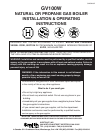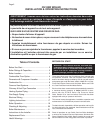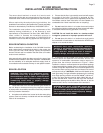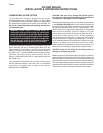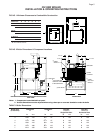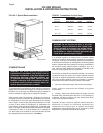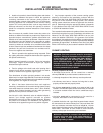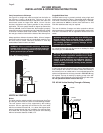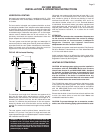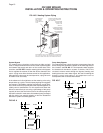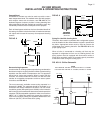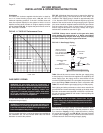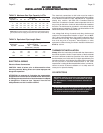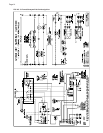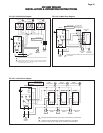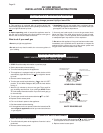
Page 8
GV100W BOILER
INSTALLATION & OPERATING INSTRUCTIONS
THIMBLE
VENT
SYSTEM
CHIMNEY
BOILER
CONDENSATE
DRAIN ASS'Y.
THIMBLE
LINER
VENT SYSTEM
CLEANOUT
CHIMNEY
BOILER
Vent Connections to Chimneys
Use Type B1 or single wall metal vent pipe from the boiler to
the chimney. If used, a 4 in to 5 in,
102 mm to 127 mm
increaser must be fastened directly to the boiler vent collar with
sheet metal screws no longer than 1/2 in,
13 mm
. Use the
shortest, straightest vent system possible for the particular
application. The vent system should be sloped up toward the
chimney 1/4 in/ft,
2 cm/m
. Ensure that the flue pipe is properly
supported and each connection securely fastened with at least
3 corrosion resistant sheet metal screws. The termination of
the vent pipe must be flush with the inside of the chimney flue.
Always provide a minimum clearance of 6 in,
152 mm
, between
single wall metal vent pipe and any combustible materials. Type
B1 vent may be used, clearance between it and any
combustible material must be as listed.
WARNING: Failure to maintain minimum clearances
between vent connectors and combustible materials
can result in a fire causing extensive property damage,
severe personal injury or death!
FIG NO. 4 Chimney Venting
VERTICAL VENTING
B Vent
The boiler may be vented vertically using the proper size Type
B1 vent pipe. Do not use the boiler as a load bearing element.
The vent system must be fully supported by the building
structure. Use an approved vent terminal at the vent outlet
which must extend at least 3 ft,
1 m
, above the highest point
where it passes through the roof. In addition, the vent pipe must
be at least 2 ft,
0.6 m
higher than any portion of the building
within a horizontal distance of 10 ft,
3 m
.
Single Wall Metal Vent
GV100W boilers may be vented vertically using single wall
metal vent pipe sized per Table 1. Galvanized sheet metal pipe
must have a minimum wall thickness of 26 gauge. In Canada,
pipe constructed of .025 in,
0.63 mm
, thick aluminum or .018
inch thick stainless steel may be required.
The use of thimbles, firestops and other protective devices
when penetrating combustible or noncombustible construction
must be in accordance with all applicable national and local
codes.
WARNING: Single wall vent pipe must NEVER pass
through interior walls or through floors or ceilings!
Failure to comply with this warning could result in a
fire causing extensive property damage, severe
personal injury or death!
An unused chimney flue can be used as a raceway for single
wall metal pipe, see FIG. NO. 4A.
WARNING: Never run vent pipe through a chimney flue
that has another appliance attached to it! Never
connect another appliance to a pressurized vent
system, it must serve only one appliance. Failure to
comply with this warning can result in excessive
levels of carbon monoxide causing severe personal
injury or death!
A listed vent terminal designed for the type of pipe being used
must complete the vertical run where it exits the chimney. If
the chimney is on an outside wall or in an unheated space the
optional condensate tee and trap pictured in FIG. NO. 4A may
be required. The trap is made by ty-rapping a loop in the 3/8"
clear plastic tubing attached to the tee and filling it with water.
Do not operate the boiler without this trap!
FIG. NO 4A Vertical Venting Through a Chimney
WARNING
S



